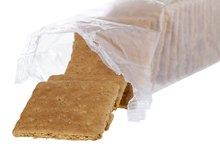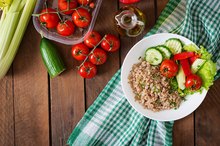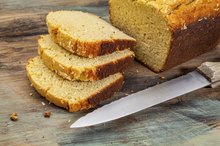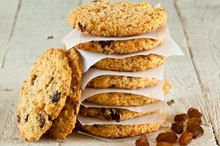What does fact checked mean?
At Healthfully, we strive to deliver objective content that is accurate and up-to-date. Our team periodically reviews articles in order to ensure content quality. The sources cited below consist of evidence from peer-reviewed journals, prominent medical organizations, academic associations, and government data.
The information contained on this site is for informational purposes only, and should not be used as a substitute for the advice of a professional health care provider. Please check with the appropriate physician regarding health questions and concerns. Although we strive to deliver accurate and up-to-date information, no guarantee to that effect is made.
How to Follow a No Flour, No Sugar Diet
If you’re trying to eat better or lose weight but don’t want to worry about measuring or counting calories, you might find it helpful to try a no flour, no sugar diet. While nutrition experts agree that there are no good or bad foods, those that contain refined white flour and sugar are usually higher in calories and less nutritious. Clearing out white breads, white pasta, sweets and desserts and replacing them with whole foods makes it easier for you to make healthier choices.
Breakfast Foods
The thought of eliminating all flour and sugar might seem too restrictive, but there are many options available for your meals and snacks. Breakfast might be the most challenging, since many traditional breakfast foods like sweetened cereals, bagels and muffins are made from flour and sugar. Eliminating these refined foods allows you to fill up more on higher protein whole foods, which actually fuels your body better, and often at a lower calorie cost. Good flour and sugar-free breakfast options include a vegetable omelet with a side of fruit, cottage cheese with vegetables and fruit, or oats with fruit, nuts and a scoop of plain yogurt.
- The thought of eliminating all flour and sugar might seem too restrictive, but there are many options available for your meals and snacks.
- Good flour and sugar-free breakfast options include a vegetable omelet with a side of fruit, cottage cheese with vegetables and fruit, or oats with fruit, nuts and a scoop of plain yogurt.
Lunchtime Choices
Are Graham Crackers Good for a Low-Carb Diet?
Learn More
If lunch is usually a sandwich, rethink the bread and try slices of lettuce to wrap your sandwich in instead, or skip the sandwich and go for a hot meal. Leftovers like grilled meat or fish with a large side of vegetables and a small serving of brown rice make for a quick and easy lunch. Many whole grains are not flour-based, so try quinoa, farro or wheat berries as the base for a salad. Top it with fresh or grilled vegetables, and toss your grain salad with a healthy olive oil-based dressing and some herbs for flavor. Stock up on raw vegetables, hummus, rice cakes and natural peanut butter for snacks.
- If lunch is usually a sandwich, rethink the bread and try slices of lettuce to wrap your sandwich in instead, or skip the sandwich and go for a hot meal.
- Many whole grains are not flour-based, so try quinoa, farro or wheat berries as the base for a salad.
Dinner Ideas
Flourless dinners are easy if you focus on a large serving of vegetables, combined with a lean protein like chicken, fish or tofu. If you want a starch, try a sweet or white potato, or a small scoop of brown rice. Since regular pasta is made from flour, switch to rice or buckwheat noodles, which are similar but not made from wheat flour. You can still top them with meat and sauce, or experiment more with seasonings like ginger, soy or hoison sauce, and vegetables for these noodles.
- Flourless dinners are easy if you focus on a large serving of vegetables, combined with a lean protein like chicken, fish or tofu.
- You can still top them with meat and sauce, or experiment more with seasonings like ginger, soy or hoison sauce, and vegetables for these noodles.
Benefits of Avoiding Flour and Sugar
What Smoothies Are Good for an Insulin-Resistant Person?
Learn More
You may find that you lose weight on a no flour, no sugar diet not only because you’ll eliminate so many higher calorie processed foods, but also because the whole foods you eat as a replacement are higher in fiber and protein and more filling, so you may crave fewer sweets and desserts. Foods that have no added sugar or refined flour also tend to have a lower glycemic index, which means they won’t spike your blood sugar and leave you hungry soon after eating them 2.
Related Articles
References
- The New York Times: Eating Well: It's Better to Be Whole Than Refined
- American Diabetes Association: Glycemic Index and Diabetes
- U.S. Department of Agriculture. FoodData Central. All Purpose Flour.
- U.S. Department of Agriculture. FoodData Central. Wheat flour, white, all-purpose, enriched, bleached.
- U.S. Department of Agriculture. USDA Nutritive Value of Foods. Updated 2002.
- Wheat Foods Council. Types of Wheat Flour. Updated 2019.
- Dahl WJ, Stewart ML. Position of the Academy of Nutrition and Dietetics: Health Implications of Dietary Fiber. J Acad Nutr Diet. 2015;115(11):1861-70. doi:10.1016/j.jand.2015.09.003
Writer Bio
Anne Danahy is a Boston-based RD/nutritionist who counsels individuals and groups, and writes about healthy eating for wellness and disease management. She holds a Bachelor of Arts from the University of Notre Dame, and a Master of Science in food and nutrition from Framingham State University in Massachusetts.









